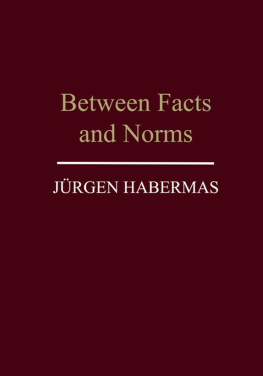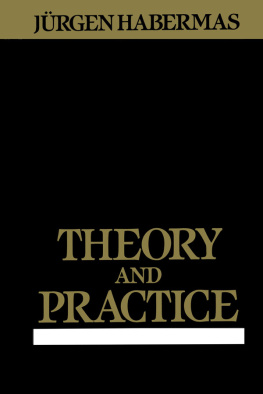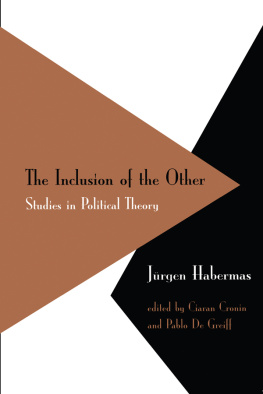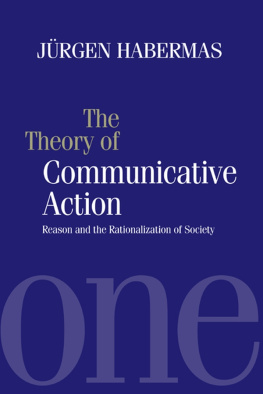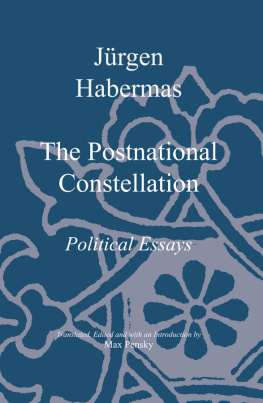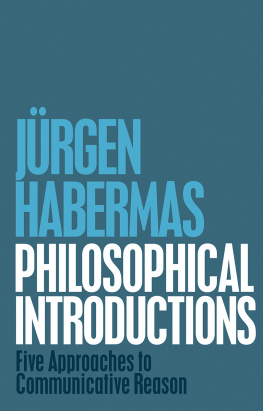J?rgen Habermas - Between Facts and Norms
Here you can read online J?rgen Habermas - Between Facts and Norms full text of the book (entire story) in english for free. Download pdf and epub, get meaning, cover and reviews about this ebook. year: 2014, publisher: Wiley, genre: Politics. Description of the work, (preface) as well as reviews are available. Best literature library LitArk.com created for fans of good reading and offers a wide selection of genres:
Romance novel
Science fiction
Adventure
Detective
Science
History
Home and family
Prose
Art
Politics
Computer
Non-fiction
Religion
Business
Children
Humor
Choose a favorite category and find really read worthwhile books. Enjoy immersion in the world of imagination, feel the emotions of the characters or learn something new for yourself, make an fascinating discovery.
- Book:Between Facts and Norms
- Author:
- Publisher:Wiley
- Genre:
- Year:2014
- Rating:3 / 5
- Favourites:Add to favourites
- Your mark:
- 60
- 1
- 2
- 3
- 4
- 5
Between Facts and Norms: summary, description and annotation
We offer to read an annotation, description, summary or preface (depends on what the author of the book "Between Facts and Norms" wrote himself). If you haven't found the necessary information about the book — write in the comments, we will try to find it.
Between Facts and Norms — read online for free the complete book (whole text) full work
Below is the text of the book, divided by pages. System saving the place of the last page read, allows you to conveniently read the book "Between Facts and Norms" online for free, without having to search again every time where you left off. Put a bookmark, and you can go to the page where you finished reading at any time.
Font size:
Interval:
Bookmark:


Copyright 1996 Massachusetts Institute of Technology
This book was originally published as Faktizitt und Geltung. Beitrge zur Diskurstheorie des Rechts und des demokratischen Rechtsstaats, copyright 1992 Suhrkamp Verlag, Frankfurt am Main, Germany.
First published in Great Britain 1996 by Polity Press in association with
Blackwell Publishing Ltd.
Reprinted 1996
First published in paperback 1997
Reprinted 1998, 2004, 2006, 2007, 2008, 2009
Polity Press 65
Bridge Street
Cambridge CB2 1UR, UK
Polity Press
350 Main Street
Maiden, MA 02148, USA
All rights reserved. Except for the quotation of short passages for the purposes of criticism and review, no part of this publication may be reproduced, stored in a retrieval system, or transmitted, in any form or by any means, electronic, mechanical, photocopying, recording or otherwise, without the prior permission of the publisher.
Except in the United States of America, this book is sold subject to the condition that it shall not, by way of trade or otherwise, be lent, re-sold, hired out, or otherwise circulated without the publishers prior consent in any form of binding or cover other than that in which it is published and without a similar condition including this condition being imposed on the subsequent purchaser.
ISBN 9780745620114 (pbk)
ISBN 9780745612294 (hbk)
A CIP catalogue record for this book is available from the British Library.
For further information on polity, visit our website: http://www.polity.co.uk
William Rehg
Both legal theory and the theory of democracy stand at a crossroads today. In the long-standing democratic regimes of the postindustrial West, problems of social complexity, pluralism, and the welfare state have been putting aged constitutional frameworks under tremendous stress. Such challenges are only intensified with the spread of democratic impulses across the globe, to areas where the cultural and infrastructural conditions for democracy and the rule of law must still be consciously constructed. In this context, one of the more fertile and optimistic theoretical developments has been associated with ideas of deliberative democracy. These ideas reflect a concern that citizens participation in the democratic process have a rational characterthat voting, for example, should not simply aggregate given preferences but rather follow on a process of thoughtful interaction and opinion formation in which citizens become informed of the better arguments and more general interests.Between Facts and Norms offers a sweeping, sociologically informed conceptualization of law and basic rights, a normative account of the rule of law and the constitutional state, an attempt to bridge normative and empirical approaches to democracy, and an account of the social context required for democracy. Finally, it frames and caps these arguments with a bold proposal for a new paradigm of law that goes beyond the dichotomies that have afflicted modern political theory from its inception and that still underlie current controversies between so-called liberals and civic republicans.
An undertaking of such scope, which pulls together three decades of reflection and interdisciplinary research, which is immersed in both German and American debates, and which moves at a number of different levels, places considerable demands on its readers. The primary goal of this introduction is to lighten that burden. If one is to understand Habermass particular approach to law, one has to have some sense of the basic features of his conceptual framework. After elucidating these in section 1, I briefly sketch the key arguments of the book in section 2. Section 3 notes certain terminological points.
Anglo-American philosophical treatises on law often begin with a definition of the concept of law itself. In Between Facts and Norms, the basic concept of law as a system of rights does not make its full appearance until chapter 3. The ambitious scale of Habermass undertaking requires considerable preparation, and thus the first two chapters set a rather elaborate stage that features both his own conceptual architectonic and the surrounding landscape of debate. The conceptual apparatus was most fully expounded in his two-volume Theory of Communicative Action, and one might read the present work as drawing out the legal, political, and institutional implications of this earlier endeavor. In this first section, I want to introduce the reader to the broader conceptual apparatus and motivate its appropriateness for the analysis of modern law and democracy. I begin by saying something about the puzzle that Habermas starts with, the paradoxical duality of modern law. We can then understand the theory of communicative action as particularly well suited to acknowledge this tension in law and deal with it constructively.
To approach the analysis of modern law in terms of a tension between facts and normsor between facticity and validity, to translate the German title of the book more literallyis not so surprising. The legal sphere has long been characterized by theorists in terms of a duality of this sort. As we shall see, this tension resides at several levels, but at each level we find a social reality on the one side and a claim of reason (which is sometimes belied by the reality) on the other. Consider, for example, compulsory laws backed by sanctions. On the one hand, such laws appear as the will of a lawgiver with the power to punish those who do not comply; to the extent that they are actually enforced and followed, they have an existence somewhat akin to social facts. On the other hand, compulsory laws are not simply commands backed by threats but embody a claim to legitimacy. Oliver Wendell Holmess insistence that we must understand law as the bad man doesthat is, look at laws only in view of the possible negative consequences of being caught at lawbreakingcannot be the whole story. In fact, many citizens are not consistently bad in this sense, and it is doubtful whether a system of law could long endure if everyone took this external approach all the time. At least some portion of a population, indeed the majority, must look at legal rules as standards that everyone ought to follow, whether because they reflect the ways of ancestors, the structure of the cosmos, or the will of God, or because they have been democratically approved or simply enacted according to established procedures. What H. L. A. Hart has termed the internal aspect of law is a function of its legitimacy or social recognition. Exactly how such legitimacy should be construed is a further question, of course. The important point is this: law is a system of coercible rules and impersonal procedures that also involves an appeal to reasons that all citizens should, at least ideally, find acceptable.
Habermas is heavily indebted to Immanuel Kants concept of legitimacy, which brings out this tension in law particularly well. Consider, for example, the basic equal rights of individual liberty, such as property and contract rights. Kant grounded their legitimacy in a universal principle of law (the Rechtsprinzip, often translated as principle of right), which can be interpreted as summarizing the conditions under which it is possible for a morally oriented subject to universalize coercible limits on the external behavior of strategically oriented individuals. According to Kant, the moral conception of law is the sum of those conditions under which the free choice (
Next pageFont size:
Interval:
Bookmark:
Similar books «Between Facts and Norms»
Look at similar books to Between Facts and Norms. We have selected literature similar in name and meaning in the hope of providing readers with more options to find new, interesting, not yet read works.
Discussion, reviews of the book Between Facts and Norms and just readers' own opinions. Leave your comments, write what you think about the work, its meaning or the main characters. Specify what exactly you liked and what you didn't like, and why you think so.

